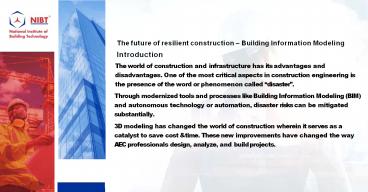The future of resilient construction – Building Information Modeling - PowerPoint PPT Presentation
Title:
The future of resilient construction – Building Information Modeling
Description:
At NIBT, we deliver comprehensive courses and modules integrated with modern technology for BIM & GIS. – PowerPoint PPT presentation
Number of Views:19
Title: The future of resilient construction – Building Information Modeling
1
The future of resilient construction Building
Information Modeling
- Introduction
- The world of construction and infrastructure has
its advantages and disadvantages. One of the
most critical aspects in construction engineering
is the presence of the word or phenomenon called
disaster. - Through modernized tools and processes like
Building Information Modeling (BIM) and
autonomous technology or automation, disaster
risks can be mitigated substantially. - 3D modeling has changed the world of construction
wherein it serves as a catalyst to save cost
time. These new improvements have changed the way
AEC professionals design, analyze, and build
projects.
2
The current plot
Looking at the current population scenario, it is
important to reflect technological advancements
from the AEC fraternity, and provide a means to
help the current population through sensitive
conditions. The word disaster carries a myriad
of meanings, which could range from human errors
in building infrastructure, usage of low quality
materials, lack of skill, or natural
disasters. The lack of knowledge in people that
move from a rural setup to an urban one creates
inferior or substandard construction that lacks
optimum structural components to withstand
disasters.
3
Understanding the word resilience comes from an
understanding that talks about the capacity of a
person, system, or thing to recover with
flexibility. It is important to understand that
resilient construction is not the same as
sustainable construction. New technological tools
and processes use resilient tools and technology
to design buildings, communities, or landscapes
that respond extremely well to any kind of
construction disaster.
4
Moving from a traditional workflow to a BIM or
automated workflow has contributed to the
resilience factor. A legacy or traditional
retrofit comprises of processes that include
limited scalability in terms of Data
Compilation Architects, engineers, and various
AEC professionals are included in this process
wherein a survey records all the measurements of
building elements viz. floors, walls, doors,
etc. This is the first data stack the second
data stack is collected and analyzed for seismic
parameters.
5
Moving from a traditional workflow to a BIM or
automated workflow has contributed to the
resilience factor. A legacy or traditional
retrofit comprises of processes that include
limited scalability in terms of Data
Conversion Vulnerability judgment Data in terms
of vulnerability includes seismic processes like
earthquakes, floods, etc. Structural study In
order to come up with a seismic calculation,
structural engineers take into consideration the
exact structural configuration of the building
or project. Retrofit outline As a conclusion of
the vulnerability assessment, the architects and
engineers come up with a proposal that includes
building elements like beams, column, etc. This
structural analysis ensures the building is
resilient during a natural disaster.
6
Moving from a traditional workflow to a BIM or
automated workflow has contributed to the
resilience factor. A legacy or traditional
retrofit comprises of processes that include
limited scalability in terms of
Documentation This process includes the process
of creating high-quality documents or docu- ment
stacks that include crucial information like
Existing building plans Study of structural
analysis Retrofit information Building
details Cost estimation or BOQ
7
Construction Process Once the construction
process is complete and approved by all the
parties internal and external, the
installation of elements like slabs, walls, and
various other elements begins. With this
traditional retrofit method, the project
experienced a myriad of bottlenecks that made
the whole process inefficient and
non-resilient. Traditional methodologies to
create spreadsheets Absence of an integrated
platform for all the stakeholders Manual modeling
techniques to include digital models into a
retrofit setting Manual hand-sketching
techniques for a geometric survey
8
BIMs contribution in disaster management New
processes like BIM integrated with modern tools
and technology optimizes disaster resilience,
performance, and sustainability for a
construction project. BIM can be referred to as
an Information and Communications Technology
nerve center that facilitates the use of
information at every stage of the project
lifecycle. The deployment of BIM is extremely
beneficial for every project phase or lifecycle
viz. design, development, FM, and demolition. The
role of BIM for pre and post disaster management
can be listed as
9
Pre-Disaster Phase The Design Phase Assess design
options Facilitate design team involvement early
on in the design process Minimize construction
waste Run structural performance resilience
simulations Design and Construction Adopt health
and safety standards Construction Phase Use lean
processes to improve onsite construction
10
Post-Disaster Phase Evacuation Rescue Quick
evacuation Asses or evaluate evacuee conduct or
attitude Governing BIM data compliance Furnishing
accurate BIM data corresponding to disaster
management Escorting evacuees to the nearest
safe locations Optimizing fire safety
11
Recovery Reconstruction Deploying 4D BIM to
enhance quality management and optimize the
process for change orders Enhance new
construction resilience
12
In Summary As we move forward into the future,
the frequency and magnitude of these natural
disasters may elevate due to various global
factors, and construction resilience would be
one of the most critical aspects of in terms of
sustainability and precautions require the
presence of global collaboration. BIM processes
and technology will play an important role in
terms of construction project management,
environment resilience, etc. It is also
important for the concept of resilience to be
integrated into work culture and practices that
augment productivity. The adoption of BIM can be
adopted to build professional governing bodies,
necessary training, relevant education, universal
codes, and robust frameworks.
Visit Us n i b t . e d u c a t i o n































